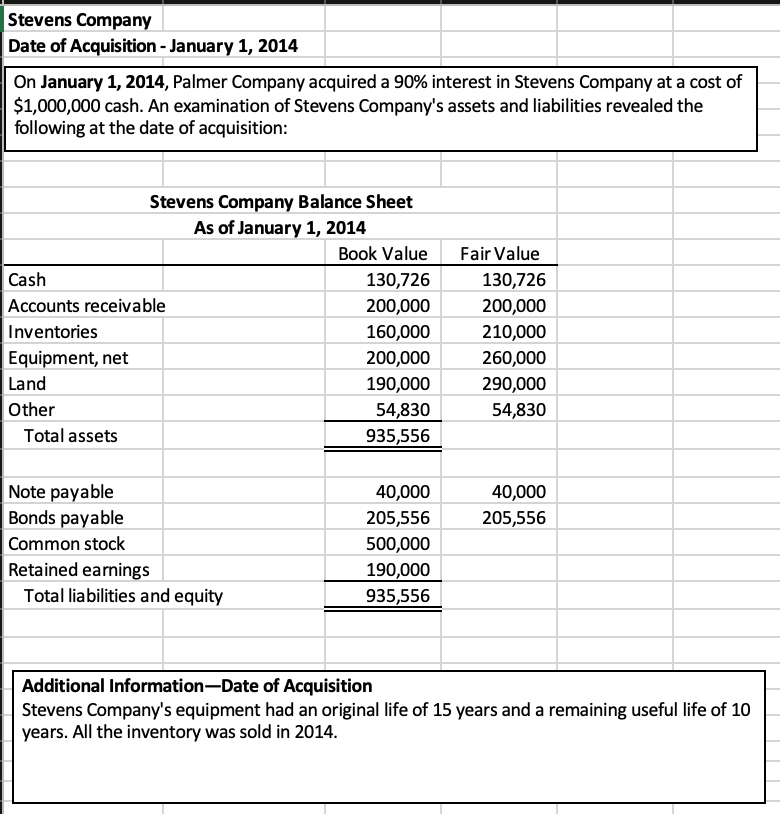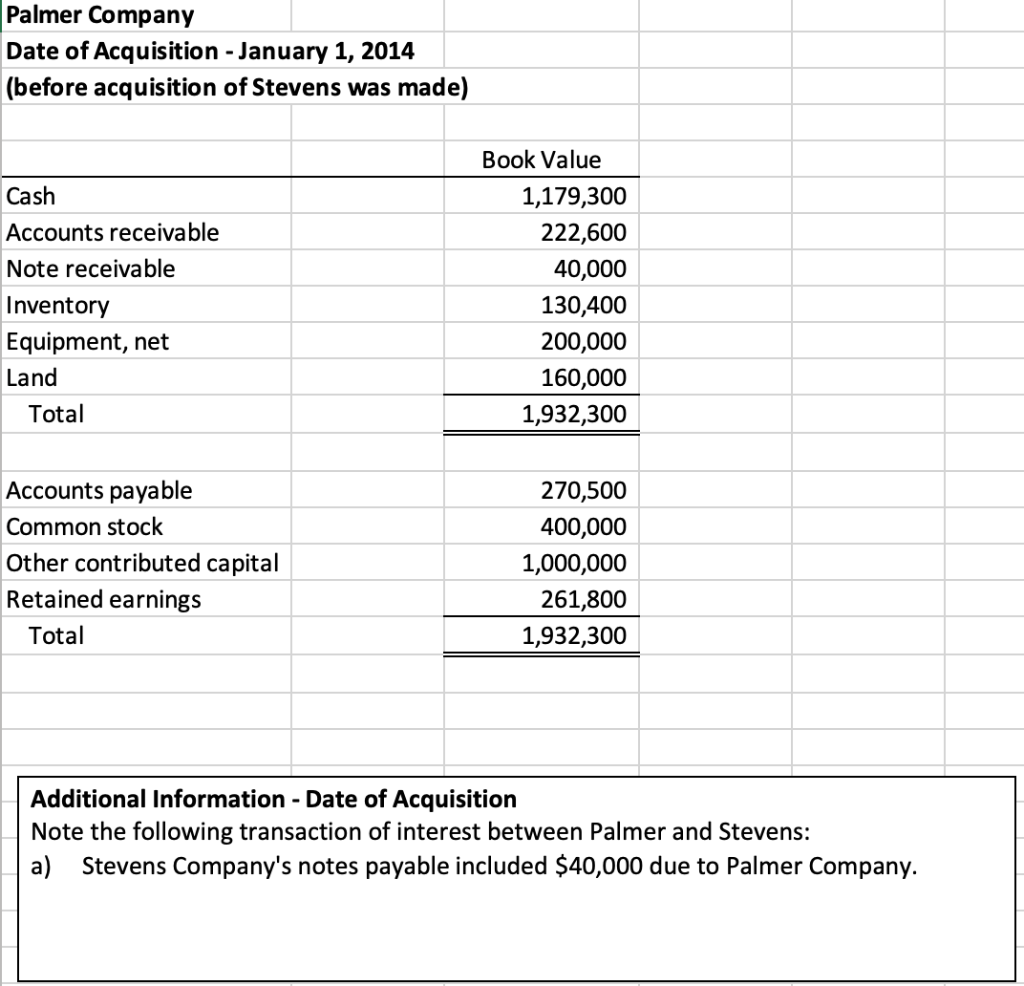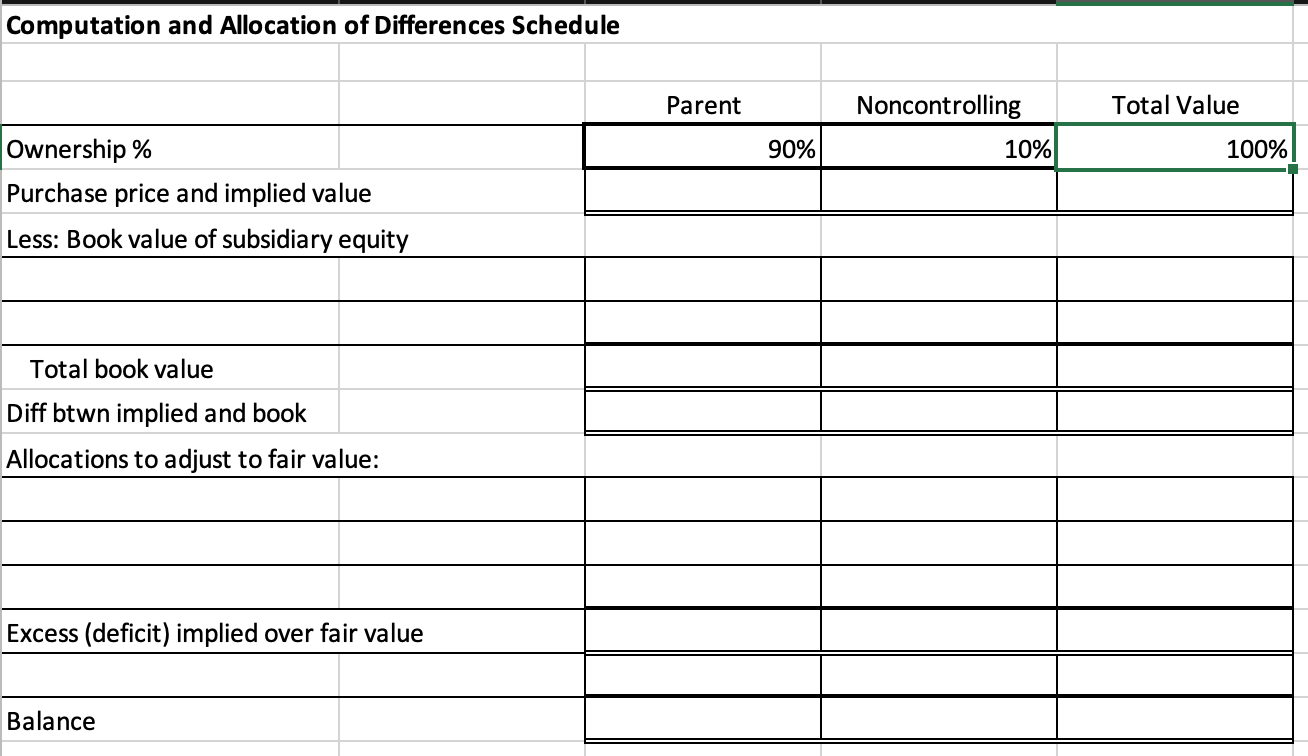Answered step by step
Verified Expert Solution
Question
1 Approved Answer
*****Prepare the Computation and Allocation of Differences schedule for the acquisition of Stevens company *****Prepare the Computation and Allocation of Differences schedule for the acquisition


*****Prepare the Computation and Allocation of Differences schedule for the acquisition of Stevens company

*****Prepare the Computation and Allocation of Differences schedule for the acquisition of Stevens company
Stevens Company Date of Acquisition - January 1, 2014 On January 1, 2014, Palmer Company acquired a 90% interest in Stevens Company at a cost of $1,000,000 cash. An examination of Stevens Company's assets and liabilities revealed the following at the date of acquisition: Stevens Company Balance Sheet As of January 1, 2014 Book Value Cash 130,726 Accounts receivable 200,000 Inventories 160,000 Equipment, net 200,000 Land 190,000 Other 54,830 Total assets 935,556 Fair Value 130,726 200,000 210,000 260,000 290,000 54,830 40,000 205,556 Note payable Bonds payable Common stock Retained earnings Total liabilities and equity 40,000 205,556 500,000 190,000 935,556 Additional Information Date of Acquisition Stevens Company's equipment had an original life of 15 years and a remaining useful life of 10 years. All the inventory was sold in 2014. Palmer Company Date of Acquisition - January 1, 2014 (before acquisition of Stevens was made) Cash Accounts receivable Note receivable Inventory Equipment, net Land Total Book Value 1,179,300 222,600 40,000 130,400 200,000 160,000 1,932,300 Accounts payable Common stock Other contributed capital Retained earnings Total 270,500 400,000 1,000,000 261,800 1,932,300 Additional Information - Date of Acquisition Note the following transaction of interest between Palmer and Stevens: a) Stevens Company's notes payable included $40,000 due to Palmer Company. Computation and Allocation of Differences Schedule Parent Noncontrolling 10% Total Value 100% 90% Ownership % Purchase price and implied value Less: Book value of subsidiary equity Total book value Diff btwn implied and book Allocations to a diust to fair value: Excess (deficit) implied over fair value Balance Stevens Company Date of Acquisition - January 1, 2014 On January 1, 2014, Palmer Company acquired a 90% interest in Stevens Company at a cost of $1,000,000 cash. An examination of Stevens Company's assets and liabilities revealed the following at the date of acquisition: Stevens Company Balance Sheet As of January 1, 2014 Book Value Cash 130,726 Accounts receivable 200,000 Inventories 160,000 Equipment, net 200,000 Land 190,000 Other 54,830 Total assets 935,556 Fair Value 130,726 200,000 210,000 260,000 290,000 54,830 40,000 205,556 Note payable Bonds payable Common stock Retained earnings Total liabilities and equity 40,000 205,556 500,000 190,000 935,556 Additional Information Date of Acquisition Stevens Company's equipment had an original life of 15 years and a remaining useful life of 10 years. All the inventory was sold in 2014. Palmer Company Date of Acquisition - January 1, 2014 (before acquisition of Stevens was made) Cash Accounts receivable Note receivable Inventory Equipment, net Land Total Book Value 1,179,300 222,600 40,000 130,400 200,000 160,000 1,932,300 Accounts payable Common stock Other contributed capital Retained earnings Total 270,500 400,000 1,000,000 261,800 1,932,300 Additional Information - Date of Acquisition Note the following transaction of interest between Palmer and Stevens: a) Stevens Company's notes payable included $40,000 due to Palmer Company. Computation and Allocation of Differences Schedule Parent Noncontrolling 10% Total Value 100% 90% Ownership % Purchase price and implied value Less: Book value of subsidiary equity Total book value Diff btwn implied and book Allocations to a diust to fair value: Excess (deficit) implied over fair value BalanceStep by Step Solution
There are 3 Steps involved in it
Step: 1

Get Instant Access to Expert-Tailored Solutions
See step-by-step solutions with expert insights and AI powered tools for academic success
Step: 2

Step: 3

Ace Your Homework with AI
Get the answers you need in no time with our AI-driven, step-by-step assistance
Get Started


